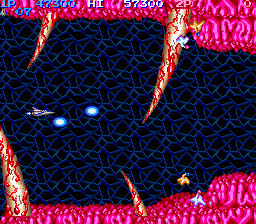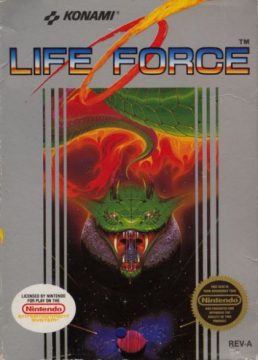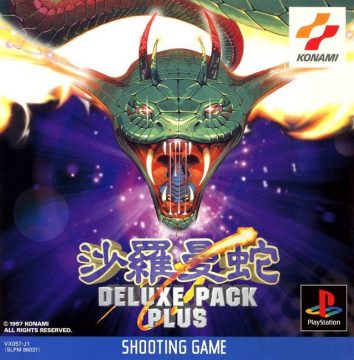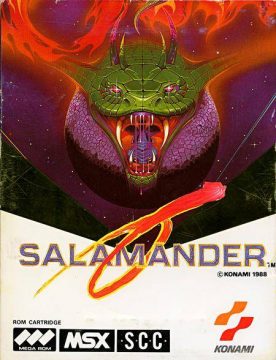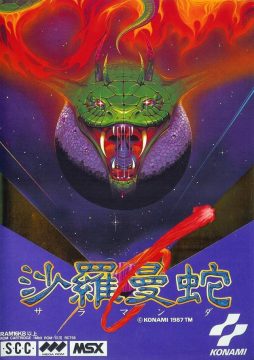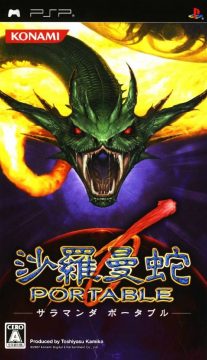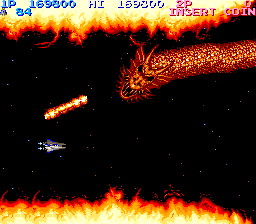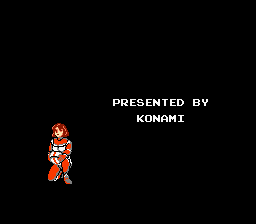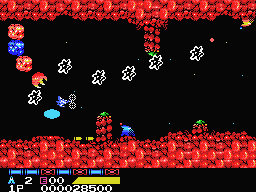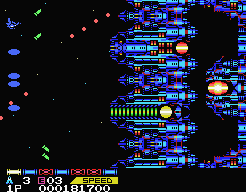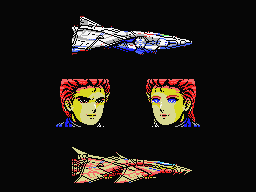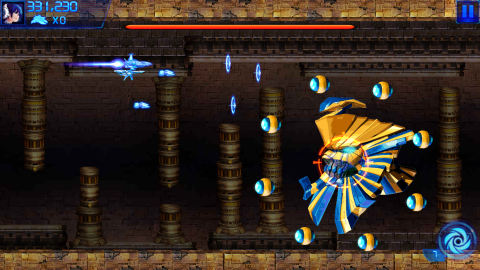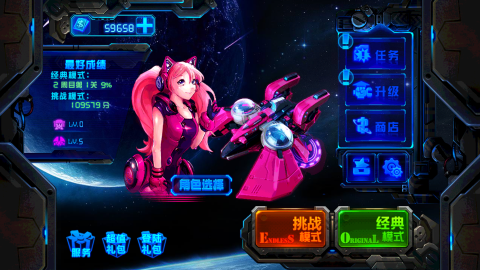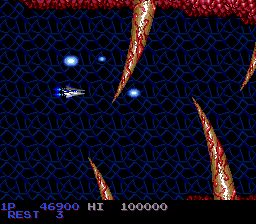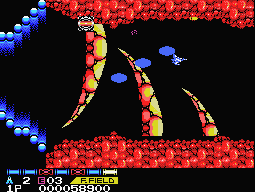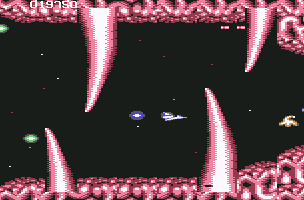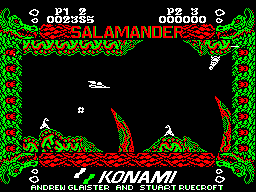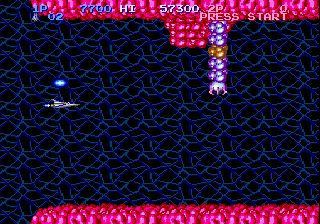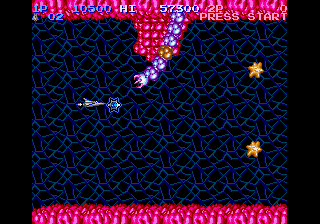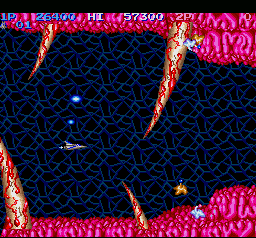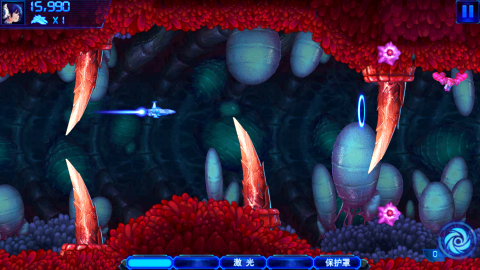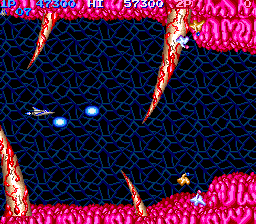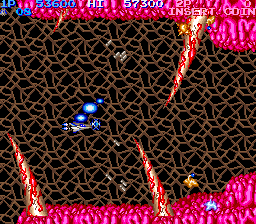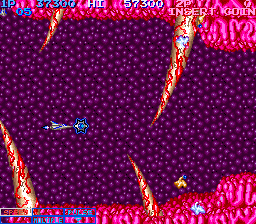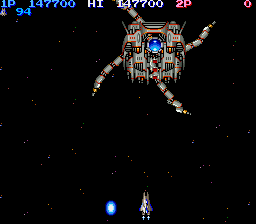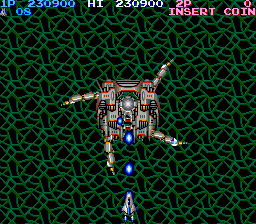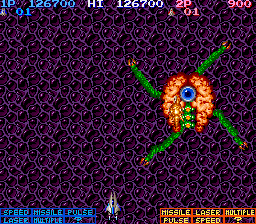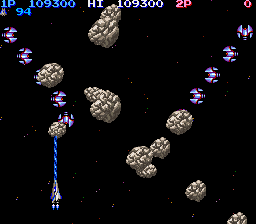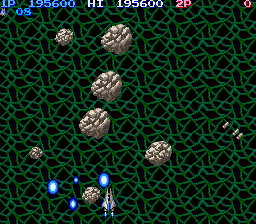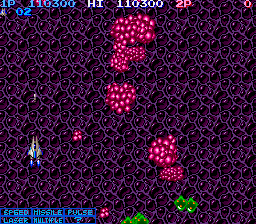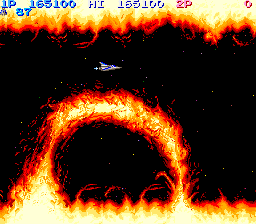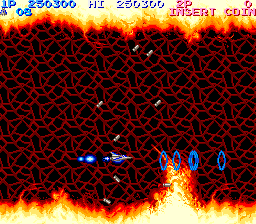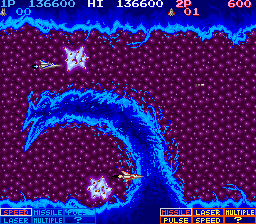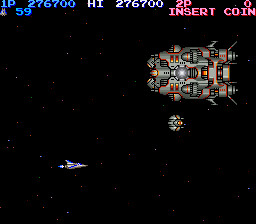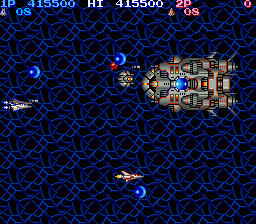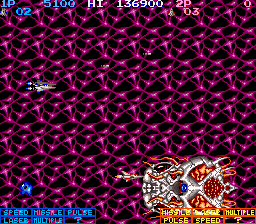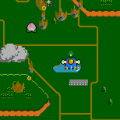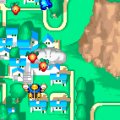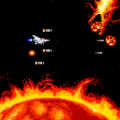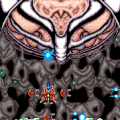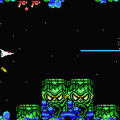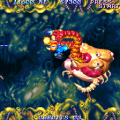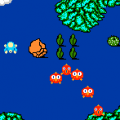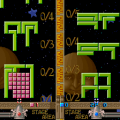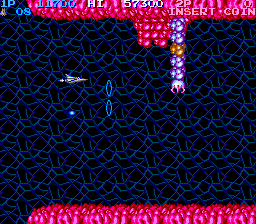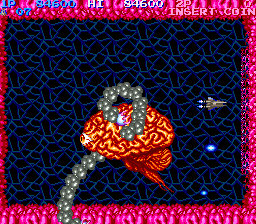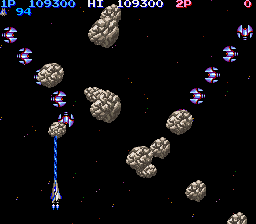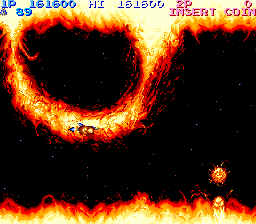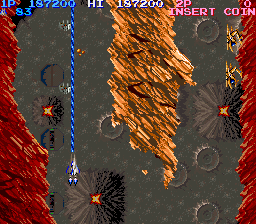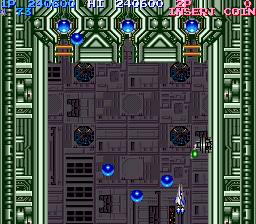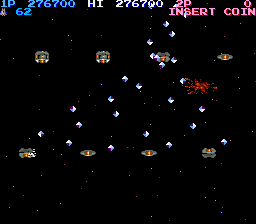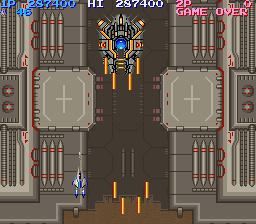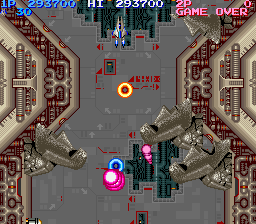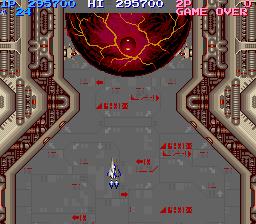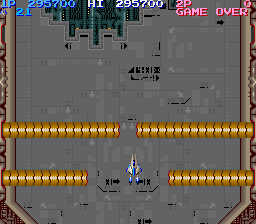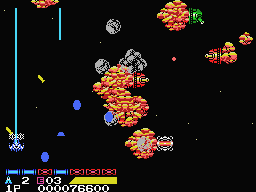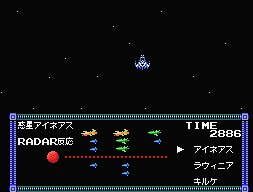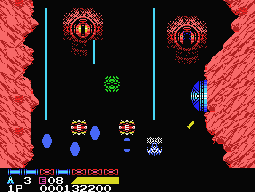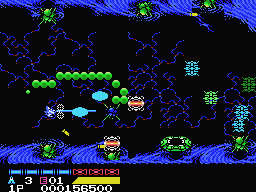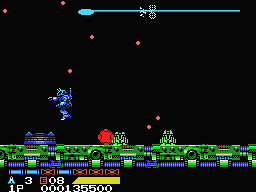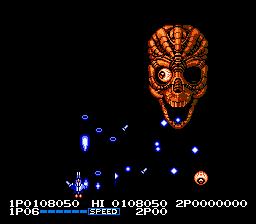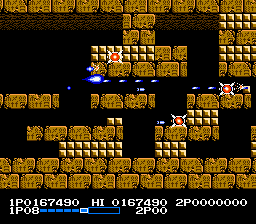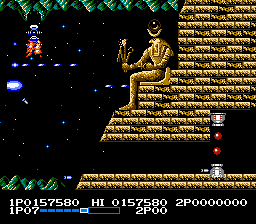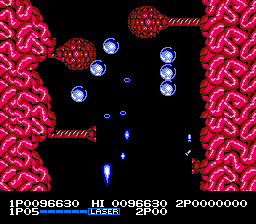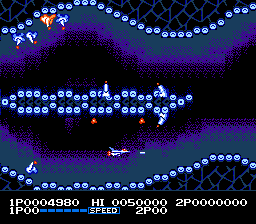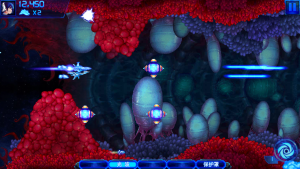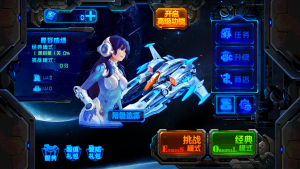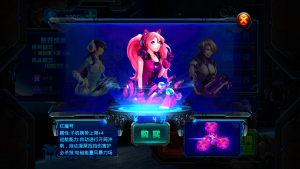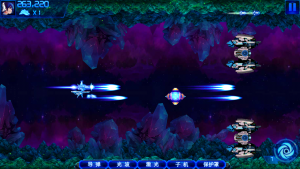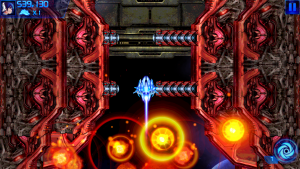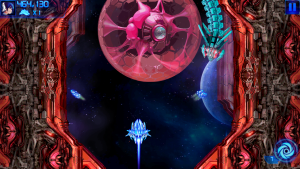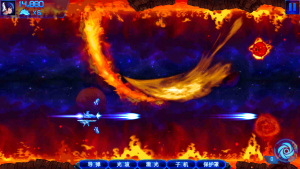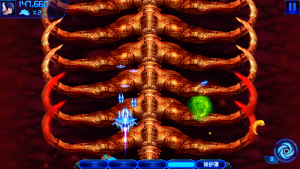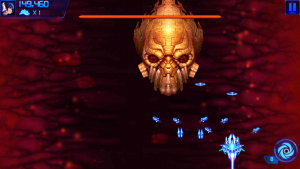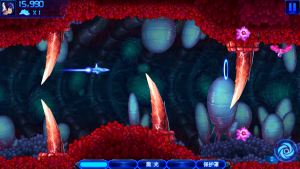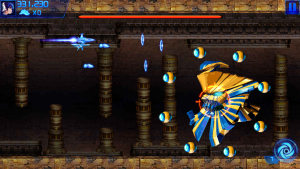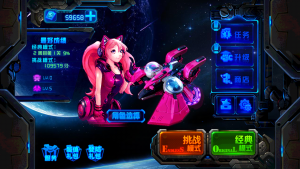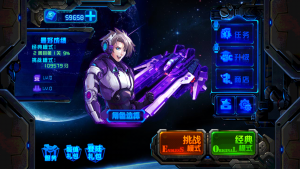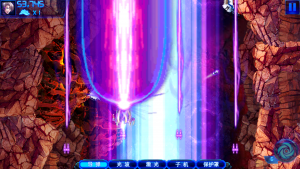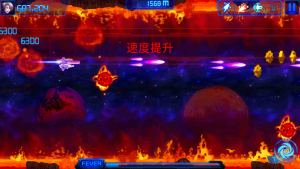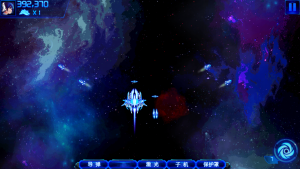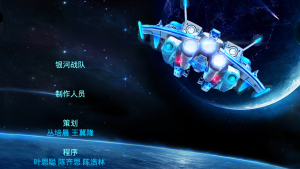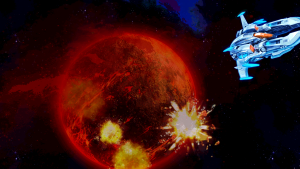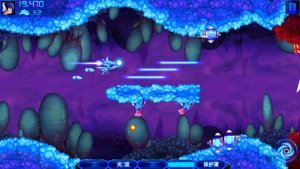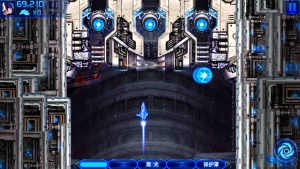Salamander was released a year after the original Gradius, and two years before Gradius II. It isn’t quite a sequel, per say. It has many of the same elements, but some of the mechanics are vastly different. It still stars the Vic Viper (although it looks a little bit different, and called the USS Light Speed in the English arcade intro), but there’s now a two-player simultaneous mode featuring a red ship called the Lord British (called the RoadBritish in the English NES manual). The goal is to save the planet of Latis from an entity known as Zelos.
The basic weapons are the same – missiles, lasers, Options and shields – but there’s a new weapon, the ripple laser, which later became another Gradius mainstay. The biggest difference is how these weapons are obtained. The weapon selection bar has been removed, and enemies simply leave behind random power-ups that can be picked up.
There are six stages in total, which alternate behind horizontal and vertical viewpoints. The first stage takes place in a huge biological monster, where you fly past a set of chomping teeth and into its body. The second stage is an asteroid field, and introduces a famed recurring enemy, the Tetran, which is similar to the Big Core boss from Gradius, but has four multi-segmented arms that spin around. The third level is a flaming tunnel, complete with huge flares that blast out at an arc. The fourth stage heavily resembles the first area of Gradius, complete with the same graphical style and enemies, while the fifth stage is another boring asteroids field. The sixth zone is an enemy base, where you have to fight a whole wave of Gradius ship bosses, before facing off against some leaping Moai heads.
Like in all of the main Gradius games, the final boss – a big, red orb called the Zelos Force – is defenseless, but the screen continues to scroll forward when you reach it. If you don’t kill it before it scrolls off the screen, you need to replay the whole stage. After killing it, the scrolling speeds up, and you need to maneuver through a set of tight corridors before you can escape.
The graphics are fantastic, especially for 1986, and it’s amazing to see the artistic advances within the single year between Gradius and Salamander. The backgrounds are a lot more detailed, and there’s actually more than one boss this time around. One of the most memorable is the first, Golem, which is a huge floating brain with an eye in the center, and tentacles that wave around in the direction of your ship. There’s a synthesized voice that announces the names of the weapons that are picked up, as well as the bosses’ weak points. The music all comes from an FM synthesizer. Compositionally, it’s pretty good, but it sounds really tinny and weak. The soundtrack was composed by Miki Higashino, who also composed Gradius.
The checkpoint system is gone too, so whenever you die, you’ll immediately restart back in the action. Unlike most arcade games, putting in an extra quarter will simply add lives, up to a pre-defined limit. Once you run out of lives completely in single-player mode, you can’t continue anymore. However, if you have a second player, you can continue indefinitely up until the last stage, where everything is cut off. Still, the difficulty level gets pretty high in the later segments of the game.
There are some tricks to get by these areas, but some are massively difficult unless you have a full arsenal of weapons. Gradius always gave you a chance to learn patterns, but Salamander has a tendency to completely flood the screen with projectiles. The screen scrolls pretty quickly, which also makes things more difficult. At least it’s easier to regain your arsenal when you’re killed, because you can grab any Options left behind from your previous life,
When Salamander was brought to America, Konami had a great idea. What if they took the first level of the game (the one where you fly into the mouth of a huge monster) and turned that into the concept for the entire game? Instead of simply fighting through disjointed levels, you’d be playing a shoot-em-up version of the movie Fantastic Voyage. To wit, they added a brief story screen, where rather than destroying a gigantic monster, you were saving a bio-mechanical warrior called Sentinel XR1 from a brain tumor that had infested its body. They also changed some of the graphics, and renamed it Life Force. It keeps the power-up system and most of the graphics from Salamander, except the outer space background is replaced with a webbed vein background, giving the impression that it’s supposed to take place in the body of a giant creature.
Apparently someone thought that this was so brilliant that they took the concept, applied even more changes, and re-released it in Japan, also using the name Life Force. The first level basically looks the same, but the second level is now the “kidney” stage, with a different background, and the asteroids changed into “kidney stones.” The third stage is now the “stomach” zone, and the flames have been recolored blue to look more like stomach acid. The fourth area is now the “liver” zone and barely looks any different. The final stage is exactly the same, as they didn’t even try to make it look biological. Some of the other bosses and enemies have been redesigned to look more organic, but most are identical.
There are many more voices, which announce the stage and make various other comments, like yelling “Fire! Fire!” as you carve through the membrane leading to the first boss. Most of the music is the same, but the themes for stage two, four, and five are different. Konami also implemented the Gradius-style power-up system for this version of Life Force. However, they didn’t rebalance the number of power-up orbs. It’s a lot tougher now to stay alive long enough to get Options or shields, whereas they were more common in Salamander.
The naming convention gets more confusing with the Famicom / NES port. It’s called Salamander in Japan, but the exact same game was renamed Life Force in North America and Europe. The game itself is a combination of elements from both games. It uses the graphics of the arcade Salamander, but keeps the Gradius-style power-up system from the Japanese arcade Life Force. The first and third stages are basically the same as the arcade versions, but the fourth stage has been moved up to become the second stage.
The fourth and fifth stages are completely new. One is another biological level, where you fight over the spine and through a giant ribcage, culminating in a fight against a giant skull. The other takes place in some Egyptian ruins, which totally doesn’t make sense in the concept of fighting through the organs of a gigantic monster, but whatever. The third level boss was also changed. In the arcade version, it’s a dragon made out of flames, but in the home versions, you only fight its head, which now takes up a huge portion of the screen. The final stage is mostly the same, except Zelos now has snakes to defend it, and you get sent back several levels if you fail to kill it, instead of just replaying the last stage.
Overall, the game is still difficult, but completely manageable compared to the ruthless arcade version. The scrolling is a bit slower than the arcade game too, so it’s not nearly as hectic. It does feature a 30-life cheat, implemented via the famous Konami code. The game cartridge featured a transparent blue plastic casing in Japan, so you could see the innards of the cartridge. It also has a slightly different ending. In the NES version, you simply see the ships escape from the exploding monster. In the FC version, there’s a credit sequence with your pilot, still wearing a helmet, on the side of the screen. The pilot takes off the helmet at the end, revealing herself to be a woman, a twist obviously borrowed from Metroid.
The graphics are quite impressive for the NES, and the PSG sound is arguably better than the arcade FM synth, even though it’s missing the voice samples. The two-player mode is still intact, although each player is limited to two Options in the NES version, and three in the Famicom. Overall, it’s an excellent port, and an outstanding game – easily one of the best shooters on the system.
The PC Engine version is much closer to the arcade game, featuring nearly identical graphics. There’s a status bar at the bottom of the screen, and the view needs to scroll up and down a tiny bit to show the entire playing field. The music is a bit better, although it’s also missing the voices. Each stage also now has a title before it. This version also uses a checkpoint system, at least in single-player mode, but it’s also less difficult than the arcade version, with some changes to the enemy patterns.
Salamander also received a handful of ports to Western home computers. The Commodore 64 version is pretty remarkable, because it looks fantastic and plays very well too. There’s some flickering and slowdown, and it’s missing the fourth and fifth stages, as well as the two-player mode, but it’s one of the better arcade shooter ports for the computer. The Amstrad and Spectrum ports are identical, and not only look terrible, but are nearly impossible to control and heavily compromised. They also contain only four stages.
The MSX port of Salamander is drastically reworked from all of the others. The first two levels are variations on the first two stages of the arcade game, but the following three can be played in any order. One of them is similar to level four of the arcade game, while the other two are entirely new. The lights flicker on and off in one, requiring you to navigate your ship in the dark. The final stage is a variation on the last level of the arcade game, although there’s a new boss after defeating Zelos Force, called Metal Slave.
It also carries over a few elements from Gradius 2 for the MSX. In order to get the best ending, you need to uncover hidden “predictions” found in each stage. Sneakily enough, the only way to get to the real final level is by sticking Gradius 2 in the second cartridge slot. Additionally, certain enemies will drop “E” capsules. When you grab fifteen of these, you’ll be granted a new weapon. Upgrading your lasers is essential if you want to find all of the predictions. There’s also an intro cinematic that details the plot and introduces two new characters – Iggy Rock, pilot of the Sabel Tiger, and Zowie Scott, pilot of the Thrasher.
Like all of the MSX games, the choppy scrolling makes things brutal, but it’s cool to see an alternate take on the game, and it manages to keep the two-player mode, which is impressive. It also appears in emulated form on the MSX Antiques packs for PlayStation and Saturn. Strangely, it was left off the Salamander Portable pack for the PSP in favor of Gradius 2 for the MSX.
The X68000 version, ported by Sharp, is nearly arcade perfect. The arcade renditions of Salamander and Life Force also show up on the Salamander Deluxe Pack Plus and Salamander Portable compilations. There is no way to increase the continues in the PlayStation and Saturn ports in single player mode, but you can insert extra credits in the PSP version. The Saturn version cannot display in its native resolution (256×240), so the screen is either stretched out or pillarboxed.
A mobile port for smartphones was planned for release sometime around 2015 or 2016, developed by a Chinese company. It was never officially announced, but only revealed when one of the developers leaked the Android version to the public. The visuals have been completely redrawn here in much higher resolution, so they look fantastic. It’s designed to use the touch screen to drag your fighter, like most other mobile shooters. Interestingly, it’s based on the NES/Famicom version rather than the arcade version, probably because Chinese gamers would be more familiar with this version. There are also multiple pilots, with different weapons. There appears to be some extra functionality to purchase items using real money, but since the game never went live, obviously none of these work.
The name Salamander is actually a type of Japanese wordplay called “ateji”. The title logo in kanji spells out “SARAMANDA”, the Japanese pronunciation of the word “salamander.” The kanji used is a made-up compound that roughly means “Gorgeous Silky Sand Snake.” A similar type of wordplay was used in the Japanese logo for Contra.
Screenshot Comparisons
